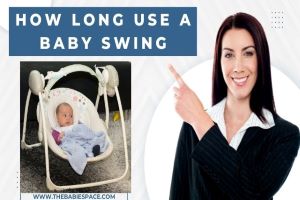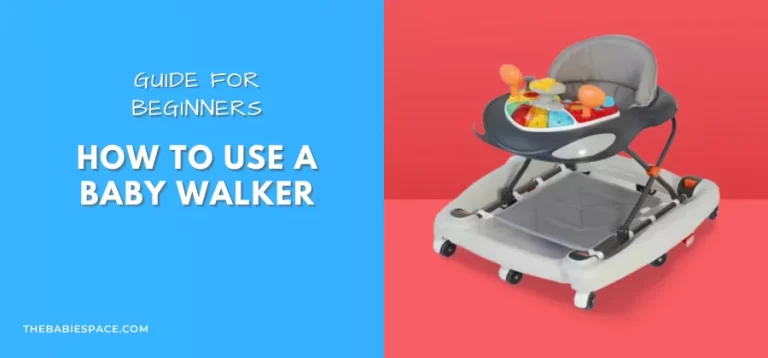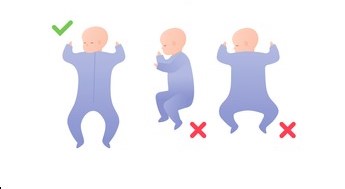How Long Can a Baby Stay In Swing? Comprehensive Guide

Last updated on July 7th, 2025 at 04:16 pm
Baby swings are an integral part of every house that contains such tiny creatures, some babies love to be held all the time which is quite difficult for parents.
Swings are a blessing for those parents and caregivers who need some arms rest after holding their fussy ones.
But many parents are often daunted about how long can a baby stay in a swing besides when should start using the baby swing.
According to the American Academy of Pediatrics (AAP), babies can generally remain in a swing BUT mostly in reclined position under 4 months of age for at least 60 minutes.
A baby should start using a swing around the age of 4 to 6 months and how long can a baby stay in a swing? for one hour divided into 30 minutes chunks.
In this article, we will help you to clear every bit of confusion related to how long can a baby use a baby swing. Some points will affect the time you should keep your baby in a swing. Furthermore will also give you some tips that can be helpful when using a swing for your little one.
How long can a baby stay in a swing? must know things
Swings are a great way to keep your newborn baby entertained and relaxed. They can be used from birth until they start rolling over on their own.
As per experts, opinion baby should stay in a swing for not more than an hour. 30 minutes duration is more reliable.
Too much time in the swing can cause problems with their development and can even lead to them becoming reliant on the swing for comfort.
Short intervals at a time should be plenty of time for your baby to get the swinging motion they need.
How old can a newborn be to use a swing
Well, the best answer is every swing manual. You can get plenty of instructions from manufacturers.
It doesn’t matter how old your baby is. If they are too young, they won’t enjoy it. If they are older, they will enjoy the movement and sound effects. As long as you find it enjoyable to watch them in the swing.
The best way to know if your baby is ready for the swing is by observing them if they are enjoying it or not.
You may also want to ask other parents who have had children before you.

Tips for using a baby swing
Is it safe for an infant to use a swing?
It’s never too early for an infant to start using a swing, but most experts recommend waiting until at least 4 to 6 months of age before introducing one into their lives.
A newborn can also use a swing as long as they can sit up on their own.
There is no harm to use a swing for a newborn. For a safe practice follow the user manual guide.
It is important to know the right time for your child when it comes to their first experience with a swing.
A few experts have recommended waiting until at least age two or three months, to make sure that they can control themselves well enough without help from you and enjoy this new fun tool on its terms!
What about safety! Excess of everything is bad but within limits nothing wrong. sound and motion provide encouragement that they need for healthy emotional growth.
How do swings entertain the baby?
Why is a swing such a great way to keep your newborn baby content and happy? Human children are more dependent on parents than animals. They are more used to being cuddled and carried since in the womb. Hence, swaddling, swings, and arms give them the same feeling.
One of the first things that infants learn how to do in early life imitates their caregivers. So when mom or dad rocks them back-and-forth gently, they begin rocking themselves just like what’s happening with this person who cares for them so much!
This establishes healthy patterns which will help develop self-regulation skills later on as well since movement stimulates sleep cycles.
Pros and cons of using a swing :
Pros of baby swings:
Cons of baby swings:
Final verdict:
Babies and swings go together like peanut butter. If you’re wondering how long can a baby stay in a swing and how old can a newborn be to use a swing then we’ve got the answer for you.
The swing is a great way to soothe a fussy baby. You can also use it as an alternative for parents who wants some hands-free time. We know that every baby is different but generally speaking, experts say babies as young as 2 to 4 months may enjoy using an infant swing if they can hold their head up well.
Yet supervised and time-specific usage is recommended for the safe side. This article has been helpful so far? Let us know by leaving your comment below!
FAQ:
Can a baby sleep in their swing all night?
Overnight sleep in the swing, car seat and recliner is not allowed. They can be left longer asleep in the swing or carrier under close supervision but in extreme conditions.
AAP recommends under 12 months of age babies should sleep on a smooth flat surface without any mess of sheets and blankets around, in addition, should be placed on their back to avoid SIDS.
Sleeping throughout the night in the swing is not safe as the swing position push baby’s chin down to the chest and can cause airway obstruction.
When should you stop using the swing with your child?
Children’s age and weight limit mentioned in the manual best suggest when you should stop using the swing with your child.
A newborn can use a swing as long as they can sit up on their own.
The best way to know if your baby is ready for the swing is by observing them








